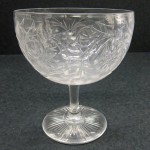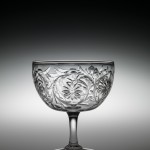There’s something remarkable about walking through our Crystal City Gallery. The light catches every cut—every engraved detail—of the hundreds of pieces on display, all of which were made in Corning. Seeing where the process starts, with a “blank” piece of glass, and how it transforms into a sparkling masterpiece is inspiring. You quickly gain an appreciation for the time and skill that goes into just one of these hand-cut pieces—the complexity and craftsmanship behind them are staggering. There’s a reason this type of glass is called “brilliant.”
The Museum’s American brilliant-cut glass collection will soon sparkle just a bit brighter. Thanks to a grant from the Henry Luce Foundation, the Museum is able to bring on two assistants dedicated to enhancing the understanding of and accessibility to the comprehensive, 1,565-piece collection of American brilliant-cut and engraved glass items.

Crystal City pattern, J. Hoare & Company and Gorham Manufacturing Company, Corning, NY, and Providence, RI, 1892. 2014.4.14.
Cut and engraved glass from the American Brilliant Period is one of the most challenging types of material to identify accurately due to similarities in patterns, lack of company records, and the movement of glassworkers from one factory to another. Kelly Conway, the Museum’s curator of American glass, knew it was time to fill in a few of the blanks.
“The majority of the Museum’s American brilliant-cut and engraved glass objects need basic information added to our database, such as pattern name and physical description,” Kelly said. “Additionally, 73 percent of the objects need updated photography to actually see enough details to make out that information.”
- Original image. The majority of the American cut and engraved collection only has this type of photography. Grapefruit Bowl, C. Dorflinger & Sons, White Mills, PA, 1920. Gift of Mr. and Mrs. Kenneth Lyon. 88.4.44.
- A new, unedited photo of the piece. Grapefruit Bowl, C. Dorflinger & Sons, White Mills, PA, 1920. Gift of Mr. and Mrs. Kenneth Lyon. 88.4.44.
With the assistance of the Luce Fund in American Art, the Museum will bring on Tiffany Williams as a curatorial assistant, and Lauren Bell as a photography assistant. For one year, they will work exclusively with American brilliant-cut and engraved glass. Tiffany will work to identify patterns, styles, and more bibliographic information on companies and their workers, while Lauren will work with the photography department to do post-production on new photos of the entire collection.
- Tiffany Williams, Curatorial Assistant
- Lauren Bell, Photography Assistant
Tiffany holds a bachelor’s degree in fashion merchandising from Virginia Commonwealth University, and a master’s in the history of decorative arts through George Mason University and Smithsonian Associates. Her graduate research focused on 20th-century French jewelry and glass. Most recently, she served as a curatorial assistant with the U.S. Department of State’s Office of Art in Embassies. Lauren graduated from Fairleigh Dickinson University with a bachelor’s degree in business administration and went on to Sussex County Community College to get an associate’s in Studio Arts, with a concentration in photography. She has held internships at the International Center of Photography, Magnum Photos, and the Metropolitan Museum of Art.
“The Museum strives to tell the story of American glass production from the 18th century to the present,” says Kelly. “American brilliant-cut and engraved glass, made between 1870 and 1940, is one of the highlights of this collection. Our goal is to better help people understand and appreciate not only our collection of this glass, but their own, as well.”
For Kelly, queries about cut glass are detailed and frequent. A woman wants to know about an heirloom passed down to her from her grandmother. A man questions a piece he found in the attic. What is this? Why is it significant? And how can I relate to it?
“Few people have their own collections of ancient glass or early American glass, but a lot of people are likely to own this type of material,” Kelly said. “There are a lot of family and emotional ties to this glass. We want to help people appreciate it.”
Once the information is gathered and the digitization is complete, the Museum will be in a better position to help patrons understand their family heirlooms, and ensure that the public connects with our extensive—and brilliant—collection, both online and here at the Museum.
“Our collection is the benchmark for other institutions, dealers, scholars, collectors, and glass enthusiasts interested in this style of American glass,” said Kelly. “We want to use the information we collect as a foundation and building block for presenting this glass in a new light.”






